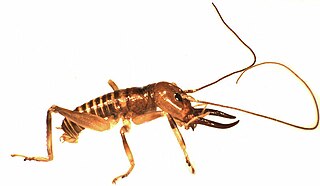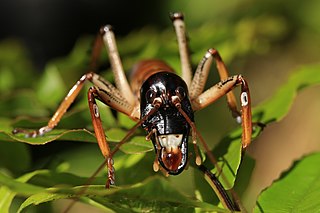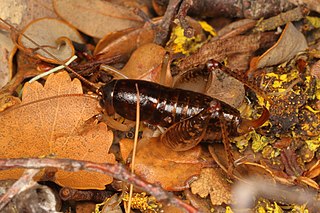
Anostostomatidae is a family of insects in the order Orthoptera, widely distributed in the southern hemisphere. It is named Mimnermidae or Henicidae in some taxonomies, and common names include king crickets in Australia and South Africa, and wētā in New Zealand. Prominent members include the Parktown prawn of South Africa, and the giant wētā of New Zealand.

Hemiandrus is a genus of wētā in the family Anostostomatidae. In New Zealand they are known as ground wētā due to their burrowing lifestyle. Hemiandrus wētā are nocturnal, and reside in these burrows during the day. Ground wētā seal the entrance of their burrow during the day with a soil plug or door so that their burrow is concealed. This genus was originally said to be distributed in Australia and New Zealand, however, with recent molecular genetic methods, this is under debate. Ground wētā adults are smaller than other types of wētā, with the unusual trait of having either long or short ovipositors, depending on the species. The name of this genus comes from this trait as hemi- mean half and -andrus means male, as the species where the female has a short ovipositor can sometimes be mistaken for a male. This genus has a diverse diet, depending on the species.

The Northland tusked wētā, Anisoura nicobarica, is a rare monotypic wētā of the family Anostostomatidae, endemic to the northern half of Northland in New Zealand, and originally described in 1932. The type specimen was wrongly labelled as coming from the Nicobar Islands, so the species was named Anisoura nicobarica. It was erroneously described again in 1950 by a different author, who placed it in the ground wētā genus Hemiandrus.
Insulanoplectron is a genus of cave wētā in the family Rhaphidophoridae, with just one species: the Snares Island Wētā. Insulanoplectron spinosum is endemic to the subantartic Snares Island of New Zealand, where it is considered to be naturally uncommon. Wētā are nocturnal crickets found all around the world. During the day on the Snares, wētā can be found hiding in seabird burrows.

Deinacrida parva is a species of insect in the family Anostostomatidae, the king crickets and weta. It is known commonly as the Kaikoura wētā or Kaikoura giant wētā. It was first described in 1894 from a male individual then rediscovered in 1966 by Dr J.C. Watt at Lake Sedgemore in Upper Wairau. It is endemic to New Zealand, where it can be found in the northern half of the South Island.

Deinacrida connectens, often referred to as the alpine scree wētā, is one of New Zealand's largest alpine invertebrates and is a member of the Anostostomatidae family. Deinacrida connectens is a flightless nocturnal insect that lives under rocks at high elevation. Mountain populations vary in colour. This species is the most widespread of the eleven species of giant wētā (Deinacrida).

Hemideina ricta, known as the Banks Peninsula tree wētā, is an insect that is endemic to New Zealand.

Hemideina thoracica, commonly known as the Auckland tree wētā or tokoriro is a cricket-like insect. It is endemic to New Zealand and is found over most of the North Island, except for the Wellington region and regions 900 metres above sea level. This species is an arboreal, herbivorous generalist however, it is also thought to be polyphagous and is found in all wooded habitats, including forest, scrub and suburban gardens.

Hemideina crassidens, commonly known as the Wellington tree wētā, is a large, flightless, nocturnal insect in the family Anostostomatidae. This wētā species is endemic to New Zealand and populates regions in the southern half of North Island/Te Ika a Maui and the north-west of the South Island/Te Wai Pounamu. They forage arboreally during the night and are most likely polyphagous. There is obvious sexual dimorphism in adults. Individuals are reliant on tree cavities for refuge, social interactions and mating.

Hemiandrus maia, the Otago ground wētā, is a species of ground wētā endemic to New Zealand. Being a ground weta, they are often found in burrows in the ground during the daytime. The species is occurs on the South Island and is classified as "not threatened". This species of wētā is unusual for an insect in that the female looks after her eggs and nymphs, this is known as maternal care.

Hemiandrus electra, the Kahurangi ground wētā, is a species of ground wētā endemic to New Zealand. Being a ground wētā, they are often found in burrows in the ground during the daytime. The species is occurs on the South Island and is classified as "Naturally Uncommon". This species of wētā is unusual for an insect in that the female looks after her eggs and nymphs; this is known as maternal care.

Hemiandrus bilobatus, the wine wētā, is a species of ground weta endemic to New Zealand. Being a ground weta, they are often found in burrows in the ground during the daytime. The species is found in Wellington, on Mana Island and northern South Island and is classified as "Not Threatened". This species of weta is unusual for an insect in that the female shows maternal care. She lays about 50 eggs in the same burrow she uses during the day and looks after her eggs until they hatch.

Hemiandrus nox, the night ground wētā, is a species of ground wētā endemic to New Zealand. During the day, this wētā hides in burrows in the soil and is active only at night. The species is found in native forests in North and South Island. Females of this species have medium-long curved ovipositers to lay their eggs in the soil. Unlike some Hemiandrus species, H. nox does not show maternal care.

Mary Morgan-Richards is a New Zealand biologist, and as of 2019 is a full professor at Massey University.

Hemiandrus maculifrons is a species of ground wētā endemic to New Zealand. They are nocturnal, carnivorous, and flightless orthopterans belonging to the family Anostostomatidae. Being a nocturnal species, individuals remain in tunnels in the ground during the day and emerge from their burrows after sunset to forage and hunt for small invertebrates. H. maculifrons is one of the smallest New Zealand weta species, averaging 15 mm in length and weighing 1–3 g. Unlike the tree weta and tusked weta, where sexual dimorphism is found in the form of male weaponry, ground weta only exhibit sexual size dimorphism: the females are larger than the males.

Wētā is the common name for a group of about 100 insect species in the families Anostostomatidae and Rhaphidophoridae endemic to New Zealand. They are giant flightless crickets, and some are among the heaviest insects in the world. Generally nocturnal, most small species are carnivores and scavengers while the larger species are herbivorous. Although some endemic birds likely prey on them, wētā are disproportionately preyed upon by introduced mammals, and some species are now critically endangered.

Hemiandrus focalis is a species of ground wētā endemic to New Zealand. This flightless Orthoptera lives in the mountains of the South Island, New Zealand. This species can be distinguished from other ground wētā by their three superior retrolateral spines on their mid tibia and females have relatively long ovipositors. This omnivorous ground wētā species is listed as "not threatened" by the New Zealand Department of Conservation.

The ground wētā population near Lake Tekapo New Zealand might represent a distinct species but it has not been formally described. The informal 'tag' name Hemiandrus'furoviarius' was given to this population by Peter Johns in 2001. Commonly known as the Tekapo ground wētā, it is a wētā of the family Anostostomatidae. They are a small, flightless, and nocturnal orthopteran endemic to the Mackenzie Basin of New Zealand's South Island.

Hemiandrus celaeno is a species of endemic ground wētā in the family Anostostomatidae. H. celaeno is a small to medium-sized burrowing wētā found along the east coast of the South Island, New Zealand. Hemiandrus calaeno is a member of the short ovipositor ground wētā. H. celaeno is named for Celaeno of the Pleiades sisters in Greek mythology, whose name means "the dark one". Tag-named entity, H. ‘horomaka’, has been included under H. celaeno.

Hemiandrus subantarcticus is a species of ground weta endemic to New Zealand.





















